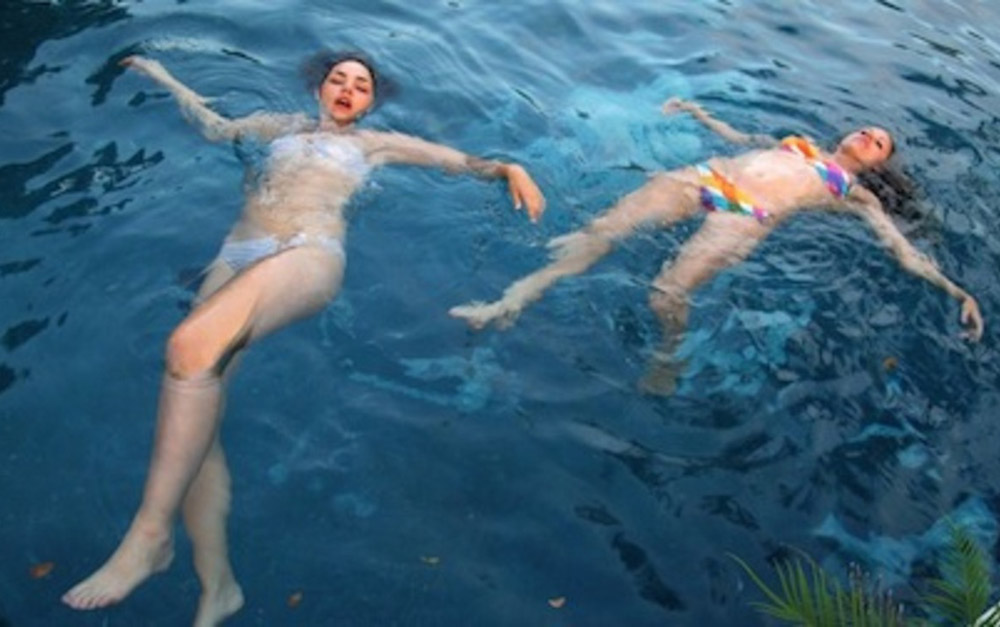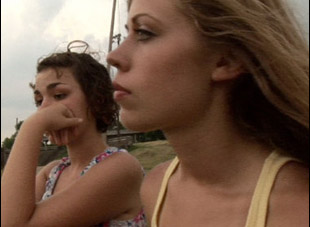An early trade review of “The Wolf Knife” counted the number of walkouts that occurred during one of its press screenings, but the film’s uncompromising nature that drove away some has made it something worth celebrating for so many others, culminating in a special screening this week at Roxy Cinema in New York as part of Screen Slate and Steak Mountain’s series “Death Takes a Holiday.” Of course, its director Laurel Nakadate is surely accustomed to such divisive reaction to her work as a renowned video artist and photographer, with exhibits at MoMA PS1 in New York and the world over, often dealing with the objectification of young women and the politics of sex. “The Wolf Knife” is no exception as it follows two teen girls (Christina Kolozsvary and Julie Potratz) on the road from Hollywood, Florida to Nashville, Tennessee in a style as stripped down as its swimsuit-clad leads.
Shot in 10 days with just two other people on crew using a car that wasn’t Nakadate’s, the production was not one for the timid. Naturally, the film that resulted is similarly brave, navigating the fragile psyche of girls on the verge of becoming women with equal aplomb as the American landscape that has long been a backdrop of her art. Nakadate may often travel a lonely road, but continues to push boundaries wherever she goes and we revisit this interview originally published on IFC.com with the artist when she was nominated for a Spirit Award in 2011 as Someone to Watch and continues to be someone to keep an eye on.
I was interested in telling a dark and awkward story about teenage girls’ relationships. In the moment between adolescence and adulthood, there is a complicated window where childhood relationships are tested and out of that testing can emerge an uncomfortable and urgent story. I was really interested in talking about discomfort, beauty and desire. I knew I could make the film the moment I met the lead actors. When I saw their faces, I knew I could tell the story I wanted to tell.
What was the best piece of advice you received that applied to the making of this film?
When I was in grad school, I was lucky enough to take classes with the very gifted photographer Gregory Crewdson. He told us a story about how, early on in his career, he left a note at a woman’s house asking if he could make a perfect circle in the grass behind her house in order to make a photograph. The woman left him a note in return saying something to the effect of “Do whatever you need to do.” I’ve never forgotten this story, and I often marvel at and find comfort in it when I’m up against a massive creative obstacle.
What was the toughest thing to overcome, whether it applies to a particular scene or the film as a whole?
I’d say it was the way I chose to cast the film. I only cast the two lead actors in advance; the entire supporting cast was found, after I’d arrived in the cities we were shooting. I loved working with all those local people in the towns we traveled to and shot in, but it was a bit harrowing at times, the uncertainty of knowing whether I would find the correct actor for the part we had to shoot the next day. Some days it was thrilling, the challenge of just going with it, and some days it was very, very, scary. I really learned to trust my gut and settle into the idea that all the pieces would fall together and that chance and fate would be more brilliant and exciting than absolute, pre-planned certainty and traditional casting approaches.
The film was shot on an extremely modest budget — the production crew was only three members. I wrote, shot, edited and directed the film. Christina, the actor who played Chrissy brought on two of her friends from school to serve as sound and productions assistants. I love that it was a challenging shoot and that the three of us managed to produce the film that we did. We had to borrow everything — camera, car, floors to sleep on, swimming pools and living rooms. It was an affirmation of the greatness of friends, trusting the creative process and the idea that if you want to make something badly enough, you will find a way to make it. I suppose that was the most gratifying thing. Humbling too.
Was there a particularly memorable moment from the shoot?
On the morning that we shot the final scene of the film, we drove to a baseball field that we’d noticed the night before. The sun was just coming up and Chrissy had to cry in front of that sunrise. I remember her standing there, in her dirty costume, tears welling up in her eyes as an airplane rose across the sky. It disappeared into the sun and then emerged on the other side. In some ways, I feel like making this film was like disappearing into the sun and being lucky enough to emerge on the other side.
“The Wolf Knife” will screen in New York at the Roxy Cinema at October 18th at 9:15 pm.





